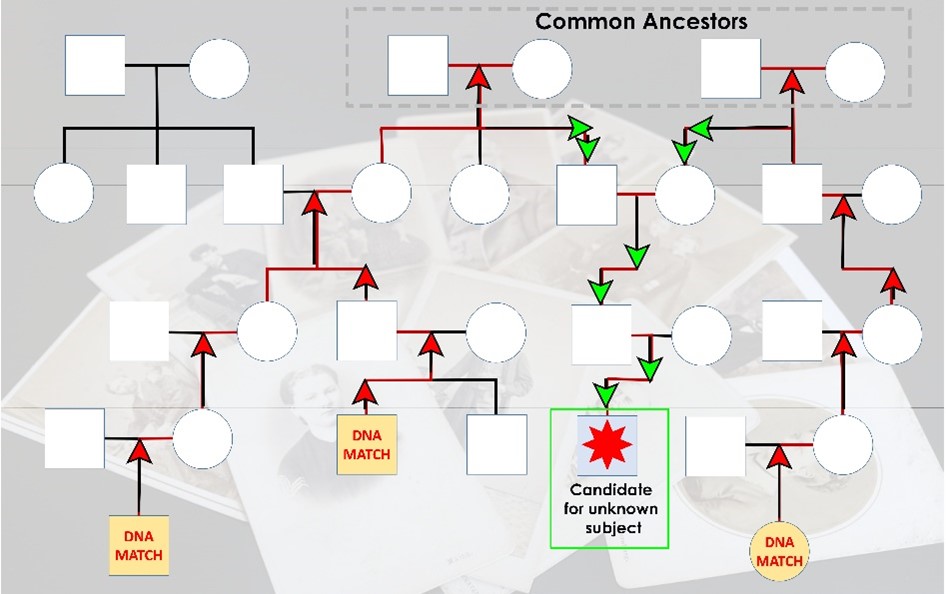What is Forensic Investigative Genetic Genealogy (FIGG)?
FIGG combines new DNA analysis techniques and traditional genealogy to identify suspects and unknown remains using commercial DNA databases. Once (often distant) relatives of the unknown individual are found on the database, family trees must be built to identify potential candidates. FIGG produces intelligence leads to investigations where other avenues have been exhausted, and where no match exists on government DNA databases.
Current DNA methods used by law enforcement look at 21 sites on an individual’s DNA. With these profiles, familial searching can identify only close family relationships, eg parent/child and siblings.
FIGG methods can test up to 1 million sites on an individual’s DNA, enabling the identification of much wider family relationships, including 3rd and 4th cousins.
Key points: FIGG uses different analysis techniques to routine NSWPF DNA casework, and profiles on our current DNA database cannot be used for FIGG.
What databases are used for FIGG casework?
There are two main consumer databases available to law enforcement for FIGG;
- GEDmatch PRO
- FamilyTreeDNA
Each database contains between 1-2 million profiles, of which only those who have agreed to be included in law enforcement searches are available for criminal investigations. Australians make up an estimated 5-10% of the individuals on these databases.
The types of cases able to be uploaded to the databases are controlled by terms and conditions, generally;
- Homicides
- Sexual Assaults
- Unidentified remains
The upload and management of DNA profiles on these databases is subject to the terms and conditions of the providers, and NSWPF adheres to the policies set by the providers.
NSWPF cannot upload or access profiles held within other public DNA databases such as AncestryDNA®, 23andme23andMe, and MyHeritage. If members of the public have already submitted DNA to these sites and would like to assist law enforcement FIGG casework, they must download their DNA data and upload to either GEDmatch PRO or FamilytreeDNA. Instructions on how to do this can be found here and here.
For any members of the public who have a close family member who is missing, the best option to assist in the identification of these relatives is through routine DNA testing, rather than FIGG. Please contact your local police station if you have a missing relative and would like to contribute reference DNA samples to assist.
Key points: Only two databases are available for law enforcement use of FIGG, and limited case types are permitted.
How is genealogy used to identify a candidate for the unknown individual?
FIGG combines traditional genealogy using historical and government records along with open-source intelligence to identify living individuals. Family trees are built back from matches to the unknown individual to identify the most recent common ancestor between two matches. From the common ancestor, family trees are built down into the present day to look for candidates for the unknown individual. The pool of candidates can be narrowed through location, age, context, and physical descriptions. When a potential candidate is nominated, identification must be confirmed with collection of an appropriate reference DNA sample to compare against the regulation DNA profile, following routine techniques.

Image credit: Dr Nathan Scudder, Australian Federal Police
Key points: The genealogical work requires skills in traditional genealogy and searching open-source records, and leads to candidates for the unknown individual that must be confirmed with routine DNA analysis.
Is NSW Police Force using FIGG?
New South Wales Police Force has undertaken a widespread review of the technique, including ethical, legal and privacy assessment within the local context. The Privacy Impact Assessment process involved wide engagement with stakeholders and provided recommendations for the safe and transparent use of FIGG for NSW. These recommendations have been incorporated into the FIGG Policy and Standard Operating Procedures for NSW Police Force. The Privacy Impact Assessment can be reviewed on request.
Following extensive review, assessment and validation, the use of FIGG has been approved for NSW casework.
Prior to use, cases must be approved by a governance board comprising legal, scientific, and investigative advisors, following strict criteria;
- Must relate to the identification of unknown human remains, or the perpetrator of a serious violent crime (generally homicide, sexual assault)
- All other routine investigative and DNA analysis techniques are exhausted, or there is a serious and immediate threat to public safety.
The policy and procedures mandate the removal of DNA from all databases on case closure, and that regular reviews of the policy and use of FIGG in NSW casework must occur.
Key Points: NSW Police Force has implemented FIGG for use in casework and is committed to the ethical and transparent use of this valuable technique.

